Related Research Articles

Cuyahoga County is a large urban county located in the northeastern part of the U.S. state of Ohio. The county seat and largest city is Cleveland. As of the 2020 census, its population was 1,264,817, making it the second-most populous county in the state.

Cleveland Heights is a city in Cuyahoga County, Ohio, United States. The population was 45,312 at the 2020 census. One of Cleveland's historical streetcar suburbs, it was founded as a village in 1903 and a city in 1921.

Parma is a city in Cuyahoga County, Ohio, United States, located on the southern edge of Cleveland. As of the 2020 census, its population was 81,144. Parma is the seventh largest city in the state of Ohio, the largest suburb in the state, and the second largest city in Cuyahoga County after Cleveland.

Carl Burton Stokes was an American politician and diplomat of the Democratic Party who served as the 51st mayor of Cleveland, Ohio. Elected on November 7, 1967, and taking office on January 1, 1968, he was one of the first black elected mayors of a major U.S. city.
Outhwaite Homes is a public development under jurisdiction of the Cuyahoga Metropolitan Housing Authority in Cleveland, Ohio. Built in 1935 by architects Edward J. Maier, Travis G. Walsh, and Leo J. Barrett and possibly named after Joseph H. Outhwaite, it was the first federally funded public housing in the Cleveland area and one of the first in the U.S. At the time of its opening, rent was listed at $4.78. The 100-plus-unit complex at East 55th Street and Woodland Avenue is, in autumn of 2011, in the final stages of redevelopment. The Outhwaite Homes, like other housing developments in the CMHA, provides residential housing for low-income families in the eastern section of downtown Cleveland.
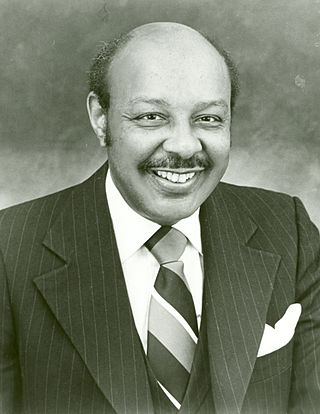
Louis Stokes was an American attorney, civil rights pioneer and politician. He served 15 terms in the United States House of Representatives – representing the east side of Cleveland – and was the first African American congressman elected in the state of Ohio. He was one of the Cold War-era chairmen of the House Intelligence Committee, headed the Congressional Black Caucus, and was the first African American on the House Appropriations Committee.
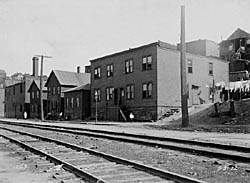
Irishtown Bend is the name given to both a former Irish American neighborhood and a landform located on the Flats of the west bank of the Cuyahoga River in the city of Cleveland in the U.S. state of Ohio in the United States. The landform consists of a tight meander in the Cuyahoga River, and the steep hillside above this meander.
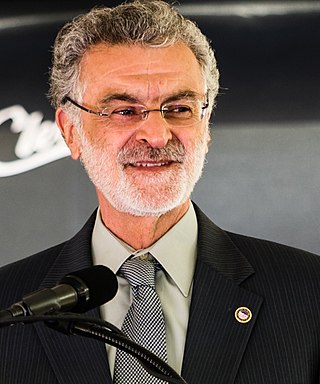
Frank George Jackson is an American lawyer and politician who served as the 57th Mayor of Cleveland, Ohio from 2006 to 2022. He was first elected on November 8, 2005, unseating incumbent Jane Campbell, and re-elected in 2009, 2013, and 2017. Having served four full terms, he is the longest-serving mayor in Cleveland history. On May 6, 2021, he announced he would not seek re-election in 2021.

The Hough riots were riots in the predominantly African-American community of Hough in Cleveland, Ohio, United States which took place from July 18 to 23, 1966. During the riots, four African Americans were killed and 50 people were injured. There were 275 arrests and numerous incidents of arson and firebombings. City officials at first blamed black nationalist and communist organizations for the riots, but historians generally dismiss these claims today, arguing that the cause of the Hough Riots were primarily poverty and racism. The riots caused rapid population loss and economic decline in the area, which lasted at least five decades after the riots.
John M. Coyne Sr. was the mayor of Brooklyn, Ohio from 1948 to 1999. Coyne held the record for the longest consecutive term of any mayor in United States at the time he left office. Coyne continued to reside in the city. He was reportedly responsible for the country's first seat belt and mobile phone laws for motorists, bringing notoriety to Brooklyn. In Brooklyn, police stopped 150 cars the first six months of the ordinance, letting drivers off with warnings. After that, minimal fines were imposed, with Coyne quoted as saying, "...because the worst thing you can do is give the impression that you're socking them for taxation."

Reserve Square is a two-building skyscraper mixed use apartment complex in downtown Cleveland, Ohio, United States. Both buildings have 23 floors and are 266 feet high. The Square is directly west of the senior residential Cuyahoga Metropolitan Housing Authority's Bohn Towers.

The Cleveland Division of Police (CDP) is the governmental agency responsible for law enforcement in the city of Cleveland, Ohio. Karrie Howard is the Director of Public Safety and Dornat "Wayne" Drummond is Chief of Police.

Hough is a neighborhood situated on the East Side of Cleveland, Ohio. Roughly two square miles, the neighborhood is bounded to Superior and Euclid Avenue between East 55th and East 105th streets. Placed between Downtown Cleveland and University Circle, Hough borders Fairfax and Cedar–Central to the South and Glenville and St. Clair–Superior to the North. The neighborhood became a target for revitalization during the mid-20th century, after the 1966 Hough Riots.
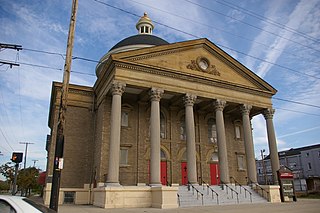
Central, also known as Cedar–Central, is a neighborhood on the East Side of Cleveland, Ohio. Situated on the outskirts of downtown, Central is bounded roughly by East 71st Street on its east and Interstate 90 on its west, with Euclid Avenue on its north and Interstate 77 and the Penn Central Railroad to the south. The neighborhood is eponymously named for its onetime main thoroughfare, Central Avenue. It is home to several schools, including East Technical High School.
The Cuyahoga Metropolitan Housing Authority (CMHA) is a governmental organization responsible for the ownership and management of low-income housing property in Cuyahoga County, Ohio. The organization was founded in 1933, making it the first housing authority in the United States.
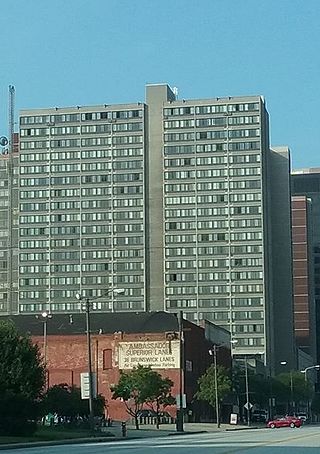
The Bohn Towers is a 1972-erected 204-foot 22-story high-rise apartment building complex in the Reserve Square area of downtown Cleveland. It is named after one of the former directors of the Cuyahoga Metropolitan Housing Authority, Ernest J. Bohn, who directed the agency responsible for public housing in the urban area of Cleveland from 1933 until 1968. The Bohn is known for its modern style apartment dwelling design, which almost approaches the brutalist style. The Bohn sits directly east of the Reserve Square East and West Towers.
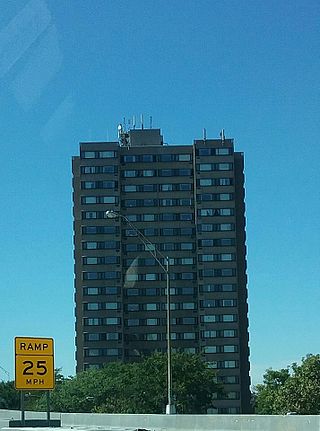
Lakeview Terrace is a set of row houses, apartments, and a high-rise residential building in the Ohio City neighborhood of Cleveland, Ohio. Established in 1935, the project culminated in the opening of a 1973 high-rise building called Lakeville Tower. The apartment tower is 208 feet tall and contains 19 stories. The complex is notable for being one of the first public housing projects in the country.
Valleyview Homes, now Tremont Pointe, was originally built in 1939 in the Tremont neighborhood, overlooking Cleveland's industrial valley. As one of the country's oldest public housing estates, the original design was a World War II barrack style layout with small units lacking contemporary amenities and was separated by 72 vertical steps. In addition, the site was adorned with a large number of Works Progress Administration (WPA) artwork. By 2004, Valleyview Homes had become one of CMHA's most distressed public housing estates, and some of the art was badly damaged.
Fairfax Intergenerational Housing project, also known as Griot Village, located in Cleveland, Ohio, is a specialized housing development for intergenerational households, the first of its kind in Ohio. The project is designed according to Enterprise Green Community standards for seniors, ages 55 and older, who have legal custody of children.
The Greater Cleveland Associated Foundation was a community foundation established in 1961 in Cleveland, Ohio, in the United States to assist other private and community foundations in and around Cleveland in establishing priorities and working to find solutions to pressing social needs. After its second round of funding, GCAF leaders merged the foundation with The Cleveland Foundation, an organization which GCAF had greatly influenced.
References
- ↑ Case Western University (1997) Bohn, Ernest J. In Encyclopedia of Cleveland History.
- 1 2 3 Jenkins, W. D. (n.d.) Ohio, Birthplace of Public Housing. Archived 2 December 2009 at WebCite
- 1 2 Ellis, W. D. (1998) Bohn's Palisades, The Cuyahoga.
- ↑ "Bohn is heckled by Landlords in Housing Plea" (1932) Cleveland Press.
- ↑ Kolson, K. (2001) Big plans: the allure and folly of urban design. Baltimore : Johns Hopkins University Press.
- ↑ Keating, W. D., & Krumholz, N. (1999) Rebuilding Urban Neighborhoods.Thousand Oaks, Calif. : Sage Publications.
- ↑ Keating, W. D., Krumholz, N., & Perry, D. C. (1995) Cleveland: a metropolitan reader. Kent, Ohio : Kent State University Press.
- ↑ "Housing leader Ernest Bohn dies" (1975) Cleveland Press.